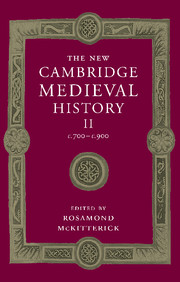Book contents
- Frontmatter
- PART I POLITICAL DEVELOPMENT
- 1 Introduction: sources and interpretation
- 2 The British Isles
- 3 Frankish Gaul to 814
- 4 The Frankish kingdoms, 814–898: the West
- 5 The Frankish Kingdoms, 817–911: the East and Middle Kingdoms
- 6 Fines Imperii: the Marches
- 7 The Vikings in Francia and Anglo-Saxon England to 911
- 8 Scandinavia, c. 700–1066
- 9 Slavs and Bulgars
- 10 The Muslims in Europe
- 11 Spain: the northern kingdoms and the Basques, 711–910
- 12 Lombard and Carolingian Italy
- 13 Byzantine Italy, c. 680–c. 876
- 14 Byzantium and the west, 700–900
- PART II GOVERNMENT AND INSTITUTIONS
- PART III CHURCH AND SOCIETY
- PART IV CULTURE AND INTELLECTUAL DEVELOPMENTS
- Conclusion
- Appendix genealogical tables
- List of primary sources
- Bibliography of secondary works arranged by chapter
- Index of manuscripts
- General index
- Frontispiece">
- Plate section
- Map 4 Charlemagne’s Europe and Byzantium, 814
- Map 19 The ecclesiastical provinces of western Europe 700-900
- Map 20 Carolingian schools, scriptoria and literary centres
- Genealogical table X: Wessex
- References
4 - The Frankish kingdoms, 814–898: the West
from PART I - POLITICAL DEVELOPMENT
Published online by Cambridge University Press: 28 March 2008
- Frontmatter
- PART I POLITICAL DEVELOPMENT
- 1 Introduction: sources and interpretation
- 2 The British Isles
- 3 Frankish Gaul to 814
- 4 The Frankish kingdoms, 814–898: the West
- 5 The Frankish Kingdoms, 817–911: the East and Middle Kingdoms
- 6 Fines Imperii: the Marches
- 7 The Vikings in Francia and Anglo-Saxon England to 911
- 8 Scandinavia, c. 700–1066
- 9 Slavs and Bulgars
- 10 The Muslims in Europe
- 11 Spain: the northern kingdoms and the Basques, 711–910
- 12 Lombard and Carolingian Italy
- 13 Byzantine Italy, c. 680–c. 876
- 14 Byzantium and the west, 700–900
- PART II GOVERNMENT AND INSTITUTIONS
- PART III CHURCH AND SOCIETY
- PART IV CULTURE AND INTELLECTUAL DEVELOPMENTS
- Conclusion
- Appendix genealogical tables
- List of primary sources
- Bibliography of secondary works arranged by chapter
- Index of manuscripts
- General index
- Frontispiece">
- Plate section
- Map 4 Charlemagne’s Europe and Byzantium, 814
- Map 19 The ecclesiastical provinces of western Europe 700-900
- Map 20 Carolingian schools, scriptoria and literary centres
- Genealogical table X: Wessex
- References
Summary
the problem of the succession was always paramount and often painful for an ageing medieval ruler. Charlemagne wept over the deaths of his two elder sons. By 813 he had only one legitimate son left: Louis, king of Aquitaine since 781. Charlemagne summoned Louis north to a large assembly at Aachen, and ‘asked everyone, from the greatest to the least, if it pleased them that he should hand over his imperial dignity to his son Louis, and they all replied enthusiastically that it was God’s choice.’ The following Sunday in the chapel at Aachen Charlemagne gave his son some fatherly precepts:
Love God; govern and defend God’s churches from wicked men; be merciful to your sisters, and to your younger brothers, and to your nephews and nieces and all your relatives; appoint loyal and Godfearing servants who will not take bribes; do not throw anyone out of his honor without good grounds for the decision.
Was Louis willing to follow these precepts? Yes. Then, and only then, did Charlemagne tell his son to take the crown from the altar and place it on his own head ‘as a reminder of all that his father had commanded’.
- Type
- Chapter
- Information
- The New Cambridge Medieval History , pp. 110 - 141Publisher: Cambridge University PressPrint publication year: 1995
References
- 18
- Cited by

